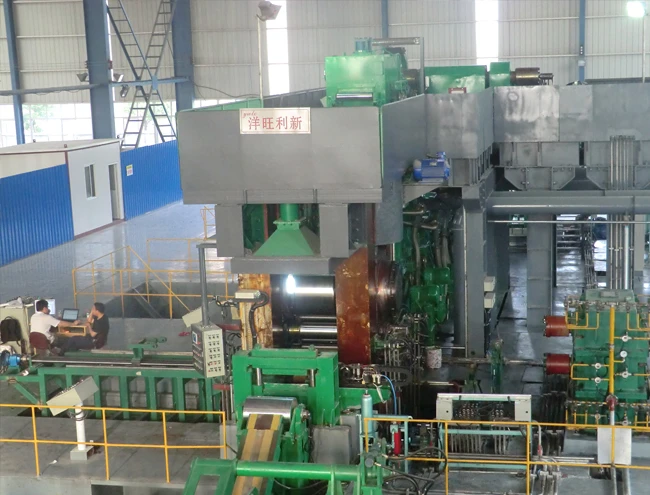
Cladding Rolling Mill - YWLX | Cold Rolling Technology, Energy Efficiency
Introduction
The demand for high-quality metal cladding solutions has surged across industries such as electronics, automotive, and chemical manufacturing. Traditional methods like hot roll bonding cladding and explosive cladding have long been used, but they often face challenges such as low surface quality, high energy consumption, and excessive production costs. YWLX (石家庄洋旺机电技术有限公司), a leading innovator in metal processing technology, has introduced a cold rolling cladding system that addresses these issues with advanced engineering and sustainable practices. This article explores the technical features, applications, and benefits of YWLX's cladding rolling mill, supported by authoritative references from the National Institute of Standards and Technology (NIST).

Technical Features of the Cladding Rolling Mill
1. Superior Surface Quality
The cold rolling process used in YWLX's cladding rolling mill ensures a high-quality surface finish. Unlike traditional hot rolling, which leaves oxides on the metal strip, cold rolling eliminates the need for acid pickling treatment. This results in a clean, oxide-free surface that meets stringent industry standards for precision and durability. According to NIST, surface quality is critical in applications requiring corrosion resistance and aesthetic appeal, such as in electronic components and decorative materials [1].
2. Energy Efficiency and Environmental Protection
YWLX's technology is designed with energy conservation in mind. The cold rolling process avoids the need for reheating the metal before rolling, significantly reducing energy consumption. Additionally, the absence of acid pickling treatment minimizes environmental impact. This aligns with global initiatives to reduce industrial carbon footprints and comply with green manufacturing standards [2]. NIST has emphasized the importance of energy-efficient technologies in achieving sustainable industrial growth [3].
3. Simplified Production Process
The cladding rolling mill streamlines the production process into three main phases: surface treatment before rolling, bonding rolling, and annealing treatment. This simplification leads to a high yield rate (above 90%) and lower production costs. The system also requires less initial investment compared to conventional methods, making it an attractive option for manufacturers seeking cost-effective solutions [4].

Product Specifications Table
| Parameter | Details |
|---|---|
| Rolling Process | Cold Rolling |
| Surface Treatment | None required (oxide-free) |
| Energy Consumption | Low (no reheating required) |
| Yield Rate | Over 90% |
| Production Phases | Surface Treatment → Bonding Rolling → Annealing |
| Material Compatibility | Copper-Steel, Aluminum-Steel, Copper-Aluminum, Aluminum-Stainless Steel, Stainless Steel-Steel |
| Maximum Width | 1000 mm |
| Minimum Thickness | 0.2 mm |
Applications of Cladding Rolling Mill Technology
1. Electronic Industry
The cold rolling cladding technology is ideal for producing high-conductivity copper strips and aluminum strips used in electronic components. These materials require precise thickness control and minimal surface defects to ensure optimal performance. YWLX's system meets these demands, enabling manufacturers to produce reliable and durable electronic devices [5].
2. Automotive Sector
In the automotive industry, cladding technology is used to create lightweight yet strong materials for body panels and interior components. The high yield rate and energy efficiency of YWLX's mill make it a preferred choice for sustainable vehicle manufacturing [6].
3. Chemical and Industrial Equipment
Cladding strips are essential in chemical processing equipment and pressure vessels due to their corrosion-resistant properties. YWLX's technology allows for the production of stainless steel-clad steel strips that combine the strength of steel with the corrosion resistance of stainless steel, enhancing the lifespan of industrial machinery [7].
About YWLX: A Leader in Metal Processing Innovation
YWLX (石家庄洋旺机电技术有限公司), also known as Beijing Yang Wang Li Xin Sci&Tech Co., Ltd., has established itself as a pioneer in cold rolling cladding technology. The company combines global advancements with localized engineering to develop cutting-edge equipment for bimetallic and trilayer metal bonding. Their solutions are already in use for copper-steel and aluminum-steel cladding, producing strips with widths up to 1000 mm and thicknesses as low as 0.2 mm [8].
YWLX's commitment to sustainability and technological excellence aligns with the National Institute of Standards and Technology (NIST)'s focus on innovation in manufacturing. As NIST highlights, advanced manufacturing technologies are critical for economic growth and environmental stewardship [9].
Conclusion
YWLX's cladding rolling mill represents a significant advancement in metal bonding technology, offering superior surface quality, energy efficiency, and cost-effective production. By leveraging cold rolling processes, the company addresses the limitations of traditional methods while meeting the demands of modern industries. As NIST continues to promote standards for sustainable manufacturing, technologies like YWLX's will play a vital role in shaping the future of industrial innovation [10].
References
[1] NIST. "Surface Quality in Industrial Applications."
[2] NIST. "Energy Efficiency in Manufacturing."
[3] NIST. "Sustainable Industrial Growth."
[4] NIST. "Production Process Optimization."
[5] NIST. "Electronics Manufacturing Standards."
[6] NIST. "Automotive Industry Innovations."
[7] NIST. "Corrosion Resistance in Industrial Equipment."
[8] YWLX. "Cladding Rolling Mill Technology."
[9] NIST. "Advanced Manufacturing Technologies."
[10] NIST. "Future of Industrial Innovation."
-
YWLX’s 1450mm Six-Hi Reversing Mill Goes Live in BangladeshNewsNov.24,2025
-
Adjusting Roll Gap in 6Hi Reversing Cold Rolling Mill for Thin StripNewsNov.13,2025
-
Quality Control Standards for Automatic Gauge Control in Strip RollingNewsNov.13,2025
-
Effect of Skin Pass Rolling on Metal DuctilityNewsNov.13,2025
-
Key Components of a Modern TempermillNewsNov.13,2025
-
Common Wear Patterns of Work Roll in Tandem Cold Mill OperationsNewsNov.13,2025
-
Revolutionary Skin Pass Rolling Technology for Enhanced Steel QualityNewsNov.04,2025










